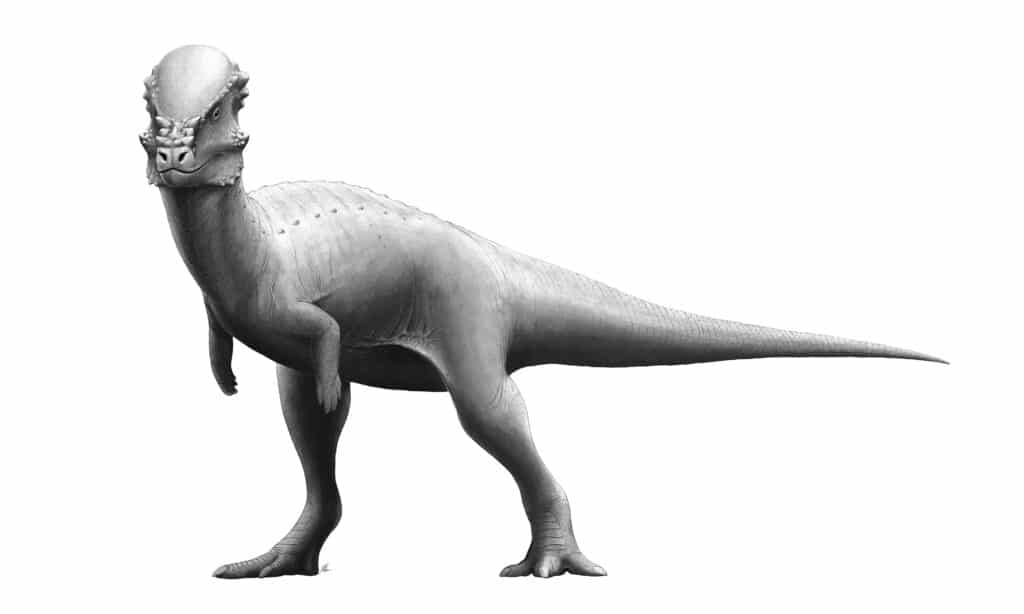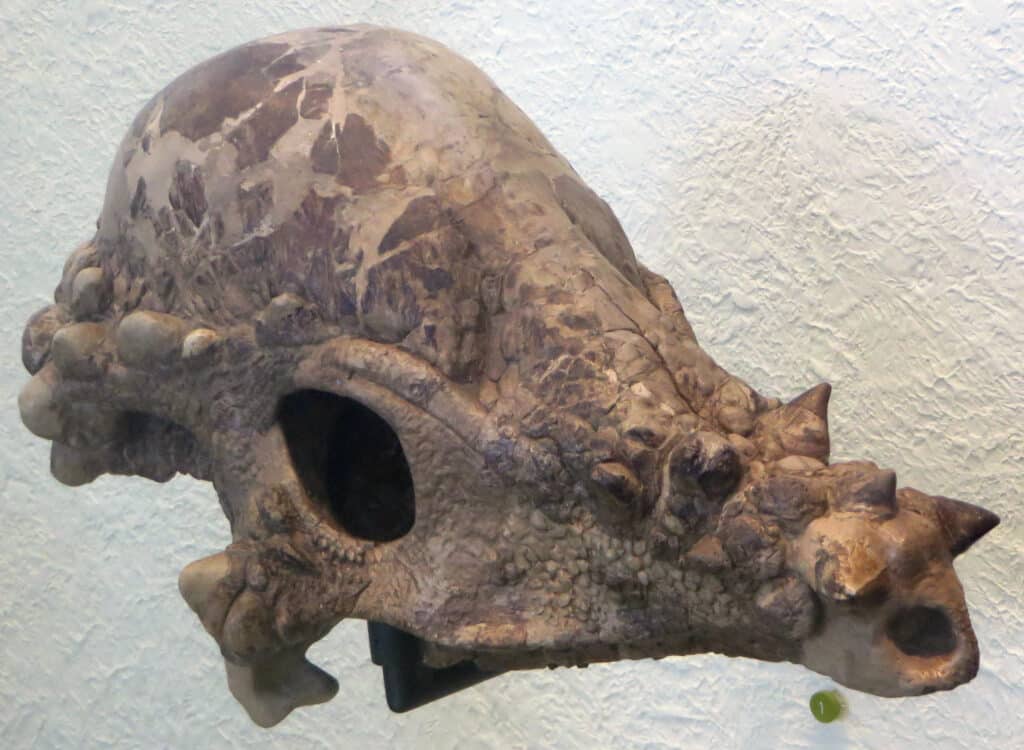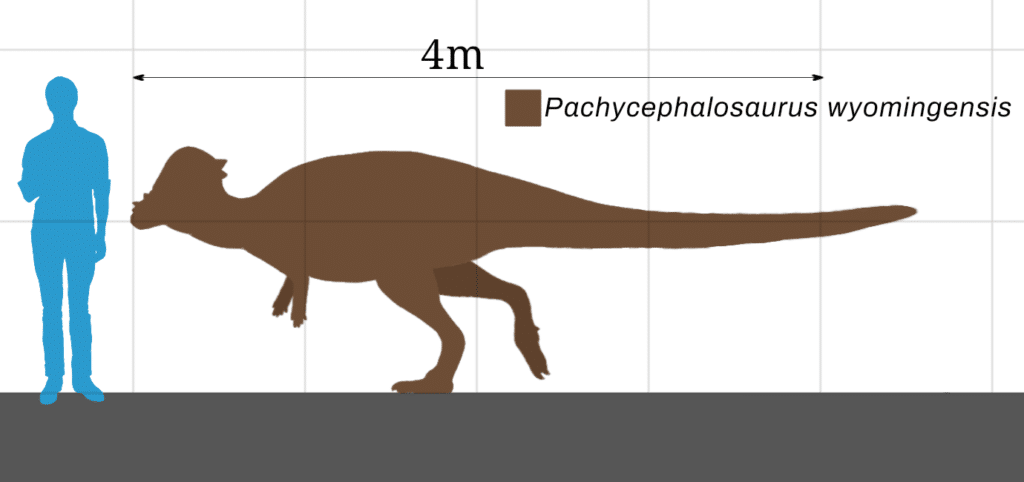In the vast and diverse world of dinosaurs, the Pachycephalosaurus holds a unique place. Its name, derived from the Greek words ‘pachys’ meaning ‘thick’, ‘kephale’ meaning ‘head’, and ‘sauros’ meaning ‘lizard’, perfectly encapsulates its most distinctive feature–a thick, dome-shaped skull. This dinosaur, hailing from what is now North America, roamed the Earth during the Late Cretaceous period, a time when dinosaurs were at their most diverse and widespread.
With its peculiar head and intriguing lifestyle, this dinosaur offers a glimpse into a world long gone. Piecing together its existence from fossil evidence paints a picture of a dynamic ecosystem where survival was a constant challenge. As we delve into the life of this remarkable dinosaur, we uncover not just its story, but also the story of our planet during a time of great biological upheaval and diversity.
Key Facts
| Keyword | Fact |
|---|---|
| Pachycephalosaurus pronunciation | pack-ee-SEF-uh-lo-SORE-us |
| Meaning of name | Thick-headed lizard |
| Group | Ornithischia |
| Type Species | Troodon wyomingensis |
| Diet | Herbivore |
| When it Lived | 72.1 to 66.0 MYA |
| Period | Late Cretaceous |
| Epoch | Maastrichtian to Lancian |
| Length | 15.0 ft |
| Height | 0.5 tons |
| Mobility | Moved on two legs |
| First Discovery | 1859 by Ferdinand Vandiveer Hayden |
| Location of first find | Montana, USA |
| Described by | 1931 by Charles W. Gilmore |
| Holotype | USNM 11892 |
Pachycephalosaurus Origins, Taxonomy and Timeline
The Pachycephalosaurus, or “thick-headed lizard”, gets its name from its most distinctive feature–a dome-shaped skull that could be up to 10 inches thick. This unique adaptation has led to much speculation and study among paleontologists, with theories ranging from use in combat to display for mating purposes.

Taxonomically, the Pachycephalosaurus belongs to the Order Ornithischia, a group of herbivorous dinosaurs known for their bird-like hip structure. Within this order, it is part of the Family Pachycephalosauridae which is characterized by their thick-skulled members. The type species of this genus was initially placed elsewhere and was originally referred to as Troodon wyomingensis. Further studies eventually placed it in the Pachycephalosaurus genus.
It lived during the Late Cretaceous period between 76 to 66 million years ago. This was a time of great diversity among dinosaurs with new species evolving and old ones dying out. This was among the last of the non-avian dinosaurs, disappearing at the end of the Cretaceous period.
Discovery & Fossil Evidence
The first fossil evidence of the Pachycephalosaurus was discovered in 1859 by Ferdinand Vandiveer Hayden in Montana, USA. Since then, additional fossils have been found in South Dakota and Wyoming, helping to further our understanding of this unique dinosaur. The fossils found include parts of the skull, vertebrae, and limb bones, providing a glimpse into the physical characteristics and lifestyle of the Pachycephalosaurus.

The first fossil discovered by Hayden was initially misidentified as belonging to a different dinosaur. It was only later with the discovery of more complete specimens that the true identity of the Pachycephalosaurus was revealed. These fossils have been instrumental in piecing together the life and times of this fascinating dinosaur. These fossils are notable for their excellent preservation. The skull, in particular, provides valuable insights into the dinosaur’s behavior and lifestyle.
Pachycephalosaurus Size and Description
The distinctive dome-shaped skull and bipedal stance help it stand out in the fossil record. These unique physical characteristics have made it a subject of much interest and study among paleontologists.
Short description of Pachycephalosaurus
The Pachycephalosaurus was a bipedal dinosaur, meaning it moved on two legs. Its body was balanced by a long, stiff tail that was likely used for stability while running. The dinosaur’s most distinctive feature was its thick, dome-shaped skull, which could be up to 10 inches thick. This skull was surrounded by small bony knobs and spikes, adding to its unique appearance.
It had a small, beak-like mouth that was likely used for cropping plants. Its teeth were flat and serrated–perfect for grinding down plant material. Despite its herbivorous diet, the front teeth resembled those of carnivorous dinosaurs, leading to some speculation about its dietary habits.
Size and Weight of Type Species
The Pachycephalosaurus was a medium-sized dinosaur. It measured approximately 15 feet in length and stood about 4.5 feet tall at the hips. The dinosaur’s weight is estimated to be around 990 lbs (0.05 tons). These estimates are based on the size and proportions of the fossils found and may vary depending on the individual dinosaur and the method used to calculate its size.

Pachycephalosaurus Games
If you want to test your knowledge about Pachycephalosaurus, here is a fun quiz you can play. Don’t worry if you don’t get all questions right, it is a learning opportunity! Have fun!
Don’t forget to try our other games as well!
The Dinosaur in Detail
The Pachycephalosaurus is a testament to the incredible diversity and adaptability of dinosaurs. The thick, dome-shaped skull of the Pachycephalosaurus is its most distinctive feature. The skull, potentially up to 10 inches thick, stands out as unique among dinosaurs, sparking numerous conversations and debates about its primary use and development.
It also had a unique stance, moving on two legs in a manner similar to modern birds. This bipedal stance, combined with its long, stiff tail, would have given the Pachycephalosaurus a balanced and agile movement, allowing it to navigate its environment with ease.
The Pachycephalosaurus in its Natural Habitat and Environment
The Pachycephalosaurus lived on the paleocontinent of Laramidia in a subtropical environment characterized by warm, humid air and an abundance of flowering plants. This lush environment would have provided ample food for this herbivorous dinosaur, which likely fed on leaves, fruits, and seeds.
As a bipedal dinosaur, it moved on two legs in a manner similar to modern birds. This would have allowed for balanced and agile movement so that it could navigate its environment with ease. It’s possible that the Pachycephalosaurus used this speed and agility to evade predators, although this is purely speculative.
It shared its habitat with many other dinosaurs, and it is likely that they had a complex web of interactions where the Pachycephalosaurus possibly fell prey to larger carnivores. However, the thick skull of the Pachycephalosaurus may have served as a form of defense, much like the armor of the contemporary Ankylosaurus, allowing it to withstand attacks from predators.
Its herbivorous diet would have played a crucial role in shaping the ecosystem around it. By feeding on plants, it would have helped to control vegetation growth and contribute to the cycling of nutrients in the environment.
The senses of the Pachycephalosaurus, like those of many dinosaurs, remain a mystery. However, its large eyes suggest that it may have relied heavily on sight. Its thick skull is often thought to primarily provide protection though it may have also housed a powerful brain. This would suggest that this was a relatively intelligent dinosaur.
Interesting Points about Pachycephalosaurus
- It is one of the few dinosaurs known to have a dome-shaped skull. This feature alone has led to much speculation and study.
- Despite being a herbivore, it had front teeth that resembled those of carnivorous dinosaurs, leading to some debate about its dietary habits.
- This is believed to have been a fast and agile dinosaur, capable of quick movements to evade predators or navigate its environment.
- It is part of the Family Pachycephalosauridae, a group of dinosaurs characterized by their thick-skulled members.
- It lived in during the Late Cretaceous period, a time of great diversity among dinosaurs.
Contemporary Dinosaurs
Hailing from the fossil-rich region of Laramidia, the Pachycephalosaurus shared its existence with a captivating array of contemporaries. Among these were the Triceratops, Tyrannosaurus, Ankylosaurus, and Edmontosaurus, each contributing to the intricate dynamics of their shared environment.
As a fellow Laramidian dinosaur, the herbivorous Triceratops might have been a competitor for plant resources. Its impressive size and formidable horns could have made it a challenging rival, yet the Pachycephalosaurus, with its thick skull, was not without its own defenses. The Ankylosaurus, with its heavily armored body and club-like tail, presents an interesting contrast to both of these herbivores. While the Pachycephalosaurus relied on its thick skull for defense, the Ankylosaurus was a walking fortress with its entire body designed for protection. This difference in defensive strategies highlights the diversity of adaptations among these contemporary dinosaurs.
The Edmontosaurus, an herbivore occupying both Laramidia and Appalachia, might have shared similar feeding grounds with the Pachycephalosaurus. Their potential interactions, whether in competition or peaceful coexistence, add another layer to the complex web of relationships in this prehistoric ecosystem.
The Tyrannosaurus, on the other hand, represented a different kind of interaction. As a renowned predator, it might have posed a threat to the Pachycephalosaurus and added a layer of tension and danger to their coexistence.Through these explorations we gain a deeper understanding of the Pachycephalosaurus’s life and the vibrant world it inhabited.
Featured Image Credit: Fred Wierum, CC BY 4.0 https://creativecommons.org/licenses/by/4.0, via Wikimedia Commons
Sources
(PDF) A taxonomic review of the Pachycephalosauridae (Dinosauria: Ornithischia)
Revision of the dinosaur Stegoceras Lambe (Ornithischia, Pachycephalosauridae)
The information in this article is based on various sources, drawing on scientific research, fossil evidence, and expert analysis. We aim to provide a comprehensive and accurate overview of the Pachycephalosaurus. However, please be aware that our understanding of dinosaurs and their world is constantly evolving as new discoveries are made.
Article last fact checked: Joey Arboleda, 06-12-2023
